Crockett & Jones ‘Makers of the Finest English Leather Shoes’ – no small boast, but certainly C&J’s claim is one to be examined seriously. This famous shoe company’s long history has been distinguished by royal patronage, a vigorous export trade, a determined focus on high quality – and a factory in the heart of Northampton’s boot and shoe quarter that is Grade II Listed (the second-highest category of historical architectural merit in the UK). Output has doubled over recent years, and C&J now make over 120,000 pairs a year, so (in volume terms) they are second only to Church’s in terms of Goodyear-welted men’s shoes.
My first visit to Crockett & Jones came about by chance some 15 years ago in the cold grey light of a new morning following a successful Monte Carlo evening that I had attended at the Northampton and County Club, hosted by the firm’s export director, at which I had won a pair of their shoes.
Since then I have been quite a regular customer of theirs, but I return today at the invitation of James Fox, the youthful executive who is responsible for their informative website, and now related by marriage to the Jones family.
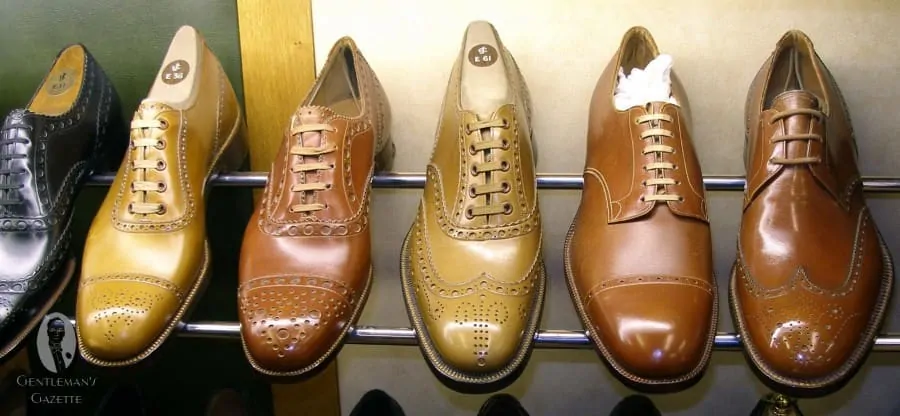
The History
Crockett & Jones’ factory occupies a large block. Parts of the building date back to 1890, a period when the Northampton shoe industry was moving rapidly from the old ‘outworking’ model to modern factory production, with the introduction of Goodyear machinery. The firm’s rapid expansion during the early parts of the twentieth century can be dated by the expansions of the factory in 1911 (into what, surprisingly, was then the biggest steel-framed building in the UK) and subsequently into another wing in 1934, which is almost art deco in style.

On my tour of the factory I was impressed by the detailing and quality of much of the premises which, despite their age, still appear to work very satisfactorily. The working areas are lit by almost floor-to-ceiling windows, and the ground floor is still paved with the original oak parquet blocks.
We begin in an archive-like showroom, lined with hundreds of their shoes – some dating back to the 1920s and 30s – which impart a strong impression of the firm’s heritage of high-quality design, linking its current range of designs with those of the past.
James talks me through the firm’s history and recent developments. We talk about leather for a while, comparing the very tight, finely grained leather of a pair of 1930s shoes with the different grades of leather that are now more common. This is attributable to changes in the process of cattle-rearing – how the animals are bred, fed, and other contributing factors. There have been dramatic changes in the meat industry over the last 50 years or so, and leather – even leather of the highest quality, as used by C&J – is only ever a by-product of the meat industry.
Fine Leather and Quality
Although C&J have been working with the best tanneries in the world for as long as they have been in business, supplies of good quality leather can never be taken for granted. On a purely personal level, I have always been slightly distrustful of large fashion-orientated corporations, so it is of vague concern to me that Hermès own John Lobb Paris (not John Lobb), and Prada own Church’s, while in France Louis Vuitton own JM Weston. Even Alfred Sargent, as I understand matters, is now owned by a French company. Each of these luxury conglomerates also owns tanneries. I do worry that should there ever be a supply bottleneck in the shoe industry, it will be in high-end leather. James, however, who does not share this perhaps unduly pessimistic Weltanschauung, goes on to assure me that – as far as he knows – Crockett & Jones is ‘not for sale’, remaining very much a family-owned firm. While Church’s response to a perceived need to change with the times seems to be to produce a more fashion-orientated product, using new varieties of leather, yet preserving certain core ranges, C&J meanwhile are concentrating on their core values:
‘When we’re focused on quality there are no compromises – you can’t ever jeopardise that.’

C&J’s meticulously sewn 1930s shoes would not look too out of place today. Indeed in Japan (an important market for C&J, where they have ‘some rather interesting accounts’) one retailer asked for a run of 1930s replica shoes to celebrate their 25th anniversary. The shoes ‘came out pretty good’. C&J seem to be leading from the front in Japan, being probably the biggest-known Goodyear-welted brand in that country. Customers there, James tells me, are
‘so passionate about what we’re doing … they have a fantastic eye for detail. Japan is such a respectful country. They love heritage – similar to old-school English. They buy a product because it’s well-made in a country they deem to be a solid manufacturing country. But at the same time they are very forward-thinking.’


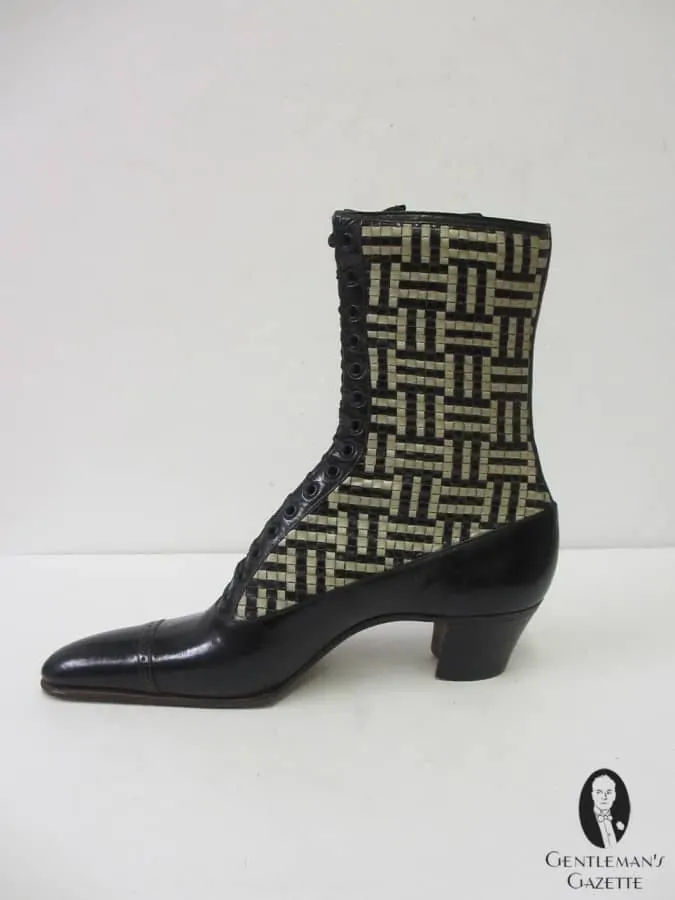

I find myself examining with interest some of the ladies’ designs, both old and new, that are on display. In the 1920s, ladies’ boots and shoes accounted for 60% of C&J’s output, but now a mere 5%. Generally speaking, I find most women’s footwear a rather lamentable story of unsound, flimsy construction married to outlandish and uncomfortable-looking styles – too much shiney plastic, too-high heels and pointy toes. Indeed, as James sagely observes, ‘It’s very difficult to find a Goodyear-welted ladies’ shoe.’ Not wishing to stir controversy, but perhaps the ladies have only themselves to blame for the shocking array of footwear that is generally available to them? C&J’s ladies’ shoes, however, I find entirely acceptable, although arguably some perhaps tend more towards the sensible, no-nonsense, tweed-and-shotgun-toting end of the female spectrum than to the ra-ra girly-girly end. What is noticeable is that C&J’s modern-day ladies’ shoes are built for broader feet than their 1920s ancestors – the company has invested heavily in lasts designed for the feet of the present-day woman.
Enough of this however; to my delight, I see some quite superb riding boots among the collection. With a pair of those, a confident rider could conquer the world. Sadly, however, it seems that these are mere historic relics, along with the lovely 1930s shoes and the wonderful open-topped Bugatti or Hispano-Suiza pictured on the wall, seen conveying a much earlier grouping of the owner’s family on a day out somewhere.
Our tour of the factory commences at a balconied area overlooking the factory floor. Down below they are very busy indeed in the shoe room, polishing, burnishing and antiquing, besides making final quality checks. The factory is currently working at close to full production capacity; any further increases in production, James tells me, are pretty much accounted for already by existing customers. Like other shoe firms, C&J are now actively involved in retailing, besides manufacturing and wholesaling, and it is clear that they have their finger on the pulse as far as the market is concerned.

![The Rough Stuff Soling Department In The 1920S. The Crockett Jones Factory Is Fundamentally Little Changed Since Then The 'rough stuff' [soling] department in the 1920s. The Crockett & Jones factory is fundamentally little changed since then](https://www.gentlemansgazette.com/wp-content/uploads/2014/01/The-rough-stuff-soling-department-in-the-1920s.-The-Crockett-Jones-factory-is-fundamentally-little-changed-since-then-900x675.webp)


In the Factory
We go first into the aromatic leather store – roll after roll of raw crust calf hide, suede, and shell cordovan, whose wrappings reveal their origins in the leading European and North American tanneries – I am asked not to name names, but they are familiar to me from visits to Edward Green and elsewhere. We emerge into the clicking department, where I am talked through the technicalities of hides and choosing which areas to use.
The clicking department manager is emphatic that C&J purchase only the finest hides – from ‘the best tanneries where it is physically possible to buy leather … and there is no better material than what we purchase for our shoes’. And having done so, they make sure that it is used efficiently. So whereas Edward Green aim to cut two pairs of uppers from each hide, at C&J they will cut four pairs. But does it follow from this that Edward Greens are better shoes than Crockett & Jones, because they use leather more selectively? Well, not necessarily; indeed it would be rather invidious to compare the respective merits of two such good shoemakers, though no doubt each has its aficionados who will do so anyway. What one can safely say is that both firms use the finest hides, from similar or indeed identical sources; and Edward Green use the leather more sparingly, while charging more for doing so. The explanation from C&J is that they make more ‘broken’ shoes (brogues and other such shoes) and can use more of the hide in this way, while still avoiding any defects. And this honest economy is reflected in the price. It is up to the individual to decide which approach is the more acceptable to them, but personally I am prepared to accept a lower price point while also satisfying my dislike of unnecessary waste of a precious commodity. But for those of the opposite persuasion, there is always John Lobb, who will perhaps better gratify the desire for exclusivity, with wholecut shoes that utilise an entire hide per pair (at a corresponding price).



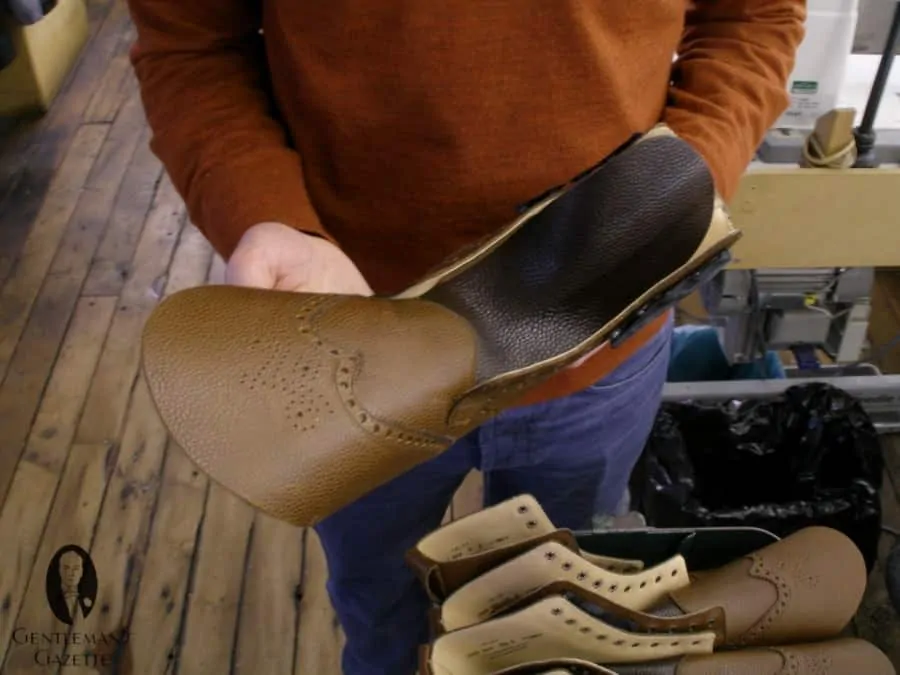
Economical clicking proceeded apace at bench after bench as we strode the department, hide after hide being carried from storage and very swiftly reduced to parts of uppers and then sent on by trolley to the closing room. Much of the clicking was done using perspex templates. At one time, brass bound templates were manufactured and bought in from specialist suppliers, but computer technology now allows them to be produced in-house.
Proceeding to the Christmas-tinselled and female-dominated closing department, the great amount of detailed work associated with brogued footwear (such as C&J’s Pembroke, a classic full-brogue derby) is apparent . Making brogued shoes, James tells me,
‘is a clicker’s dream. But in the closing room it’s an absolute nightmare. There’s a lot of different operations – double-row stitching, punching and gimping, fitting of the backers, edge-staining.’
With a brogue, there are a lot of things that potentially can go wrong. The stitching and punching must all be meticulous; yet the facility and speed with which the closers are assembling the uppers, at 12 stitches per inch, is all highly impressive.
Gimping and hole-punching can be done in various ways, ranging from use of an awl and hammer, to a variety of ingenious hand-operated machines, and ultimately a press-knife which uses a special pattern and press, cutting the gimping and punching holes and all in a single, swift operation. However, the specially fabricated patterns are very expensive, so there must be a certain production level (as is the case for the Pembroke) to make such an investment economical. Some makers therefore utilise the same pattern for a whole range of sizes, with the effect that the position of the medallion, for instance, will vary somewhat according to the shoe size. At C&J, however, there are individual press knives for different sizes.
Visible all around from the closing room windows are streets of terraced workers’ housing. At one time there was a network of micro-factories (some of these are still visible in back gardens near the factory) responsible for closing uppers for C&J. This was prior to the introduction of Goodyear welting machinery in 1920, which increased the flow of work so much that logistically all work had to be taken into the factory – but there have been very few fundamental changes in working arrangements since then.
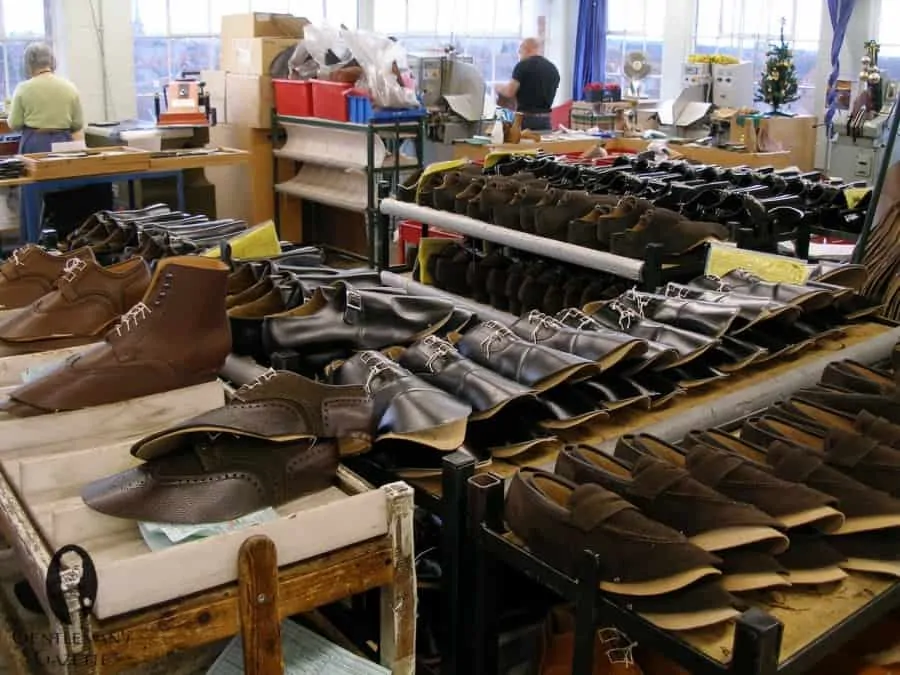



Leaving the closing room we head upstairs, to a place where there is a sort of machine museum-cum-graveyard. C&J have been buying up old machines in order to repair and utilise them, or for spares. Some of the machines came from Haynes & Cann, the wartime makers of silk-lined flying boots for the RAF, whose premises were a few streets away but closed down in 2010. The department is overseen by C&J’s ‘retired’ chief engineer. Three full-time engineers are on hand to maintain the company’s machines.
As we pass into the lasting department, I am conscious of how much larger Crockett & Jones is than any of the companies I have visited so far. Everything is on a scale three or four times larger, and where so far there has been only one or two, or at a push three lasting machines, here they seem to be everywhere. Lasting – a critical stage in shoe production – is done at C&J in three discrete stages: toe-lasting first, then side-lasting, and finally seat-lasting. Unfortunately it is now the lunch hour and most of the 280 or so staff are dispersed, so the lasting and other machinery is suddenly silent.
The trolleys of shoes slowly advancing through the factory are stilled, and I take in the great variety of different styles all going through the factory together in quite small batches – at first glance it seems an inefficient way of doing things in a business producing so many shoes, but in fact this is dictated by customer requirements and, presumably, the avoidance of stockholding bottlenecks. C&J’s website reveals there are over 200 models and variations of men’s shoes, multiplied of course by the various permutations of size and fitting; and the website is merely a fraction of everything they do. Crockett & Jones export 70% of their production with some 40% of total production their work is actually made up of MTO – made to order shoes are styles outside of their core stock programme, offering wholesale customers a margin of flexibility to deviate from the norm, giving their collection of C&J shoes further identity. A Special Order service is also offered through all Crockett & Jones retail shops which enables an end consumer to completely change the specification (within reason!) of any style previously made by Crockett & Jones. Immediately, one sees there is an almost infinite set of permutations, all of which must be executed perfectly, while retaining those special characteristics that constitute C&J’s DNA.
C&J Design
Thinking of design, what is it that distinguishes C&J’s? Like any good shoe, they fulfil the basic requirement of disguising that sometimes ugly human appendage, the foot, transforming it somehow into a shape that is pleasing to the eye. An elegant, sophisticated shape, high-quality materials and skilful construction are all parts of the mix. I ask James about the C&J design process. Ideas are pulled from their French and Italian agents, from Japanese customers; however, all their designs are in-house:
‘It’s an organic process … an evolution. You need to know the history of the company and its shoes – you need to know where a style came from to know where it’s going to go. That is a ten-year learning process.’
C&J’s MTO work allows them to trial new designs, new colours, new leathers. For instance the Coniston boot is 30 years old, but recently they introduced a navy grain version that makes one look again at the model. Back in the sample room, the eye is drawn to the many subtle contrasts in colour of stitching and leathers, welts, laces, elastic sides – subtle injections of colour abound. However, the on-line world can give a very misleading picture of the shoe trade. The reality is that five or six of C&J’s black toe-cap oxfords are always their biggest sellers: they sell 20-25,000 pairs a year. The styles that most customers really want are much more conservative than the more eye-catching designs we shoe obsessives tend to become fixated by.






One topic that has been mentioned from time to time in various on-line blogs is that of ‘gemming’ or ‘ribbing failure’, whereby the sole and uppers of the shoe supposedly part company catastrophically with the insole. It is not something I have ever come across in real life and when we are in the welting department I decide to raise the issue with James, who is rather dismissive of the idea:
‘We’ve never had a rib fail. We’ve been making shoes for 130 years and there is a reason why we are still making shoes in this way.’
He points out that in a Goodyear welted shoe, the insole is effectively encased by the chainstitch of the welt and the lockstitch of the upper. Although C&J have a fairly active repairs department looking after shoes that are returned for resoling (some of whose owners appear to treat their shoes with a degree of abuse and neglect I find surprising), they have never had a pair of shoes returned that have had rib failure.
So we come finally to the finishing rooms, where the sole is finished, edges trimmed (an extremely important process if the shoe is to attain the necessary C&J standard of elegance), waxed and/or stained. Heels are all made in house rather than bought in. Here, the uppers are finished – antiquing, burnishing, polishing and quality control all take place. I come across a trolley-full of Tetbury chukka boots (one of the James Bond shoes) – they have a very distinctive, angular, chiselled shape that I like, it’s a shoe that to me seems to capture something special about C&J. But then I like the Islay too, and the Coniston, the Skye, the Cottesmore, the Snowdon. And as for the Grasmere – I’ve got three pairs of those …
Collection Prices
| Main Line Collection: | £295–£450 / $500 – $750 |
| Hand Grade Collection: | £465–£500 / $765 – 825 |
| Hand Stitched Collection: | £575 / $950 (Styles: Bury & Clarendon only) |
| Shell Cordovan Collection: | £495–£600 / $ 800 – $1000 |
| Mens Slipper Collection: | £165-£215 / $275 – $350 |
| Ladies Collection: | £265–£425 / $435 – $700 |
| Ladies Slipper Collection: | £165–£245 / $275 – $400 |
| Belt Collection: | £85–£650 / $140 – $1075 |
Where to see and buy
Online: Pediwear has a great selection online.
Stores
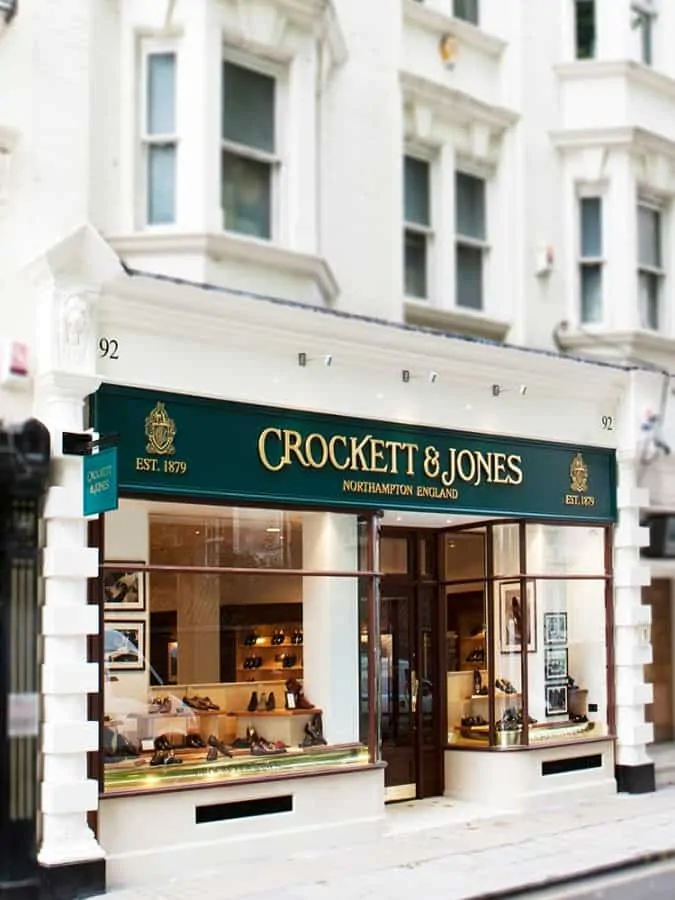

Just bought myself a very nice pair of Derbies from the store in Brussels. I have to say I am very impressed with the quality and look. As the sales are just on, I fetched it a 100 Euro cheaper. I might go back for another pair…. ;-)
Thank you for a great article. I was intrigued by the lack of quality Lady’s shoes today. I agree that most Lady’s shoes are all about fashion without style, comfort or quality.
What I also found interesting is the fact that gentleman’s shoes are still produced in the same range of colours. It looks like that shoes, hats and gloves do not change and are very little influenced by fashion colours.
Black seems unlikely to lose its popularity in the foreseeable future. Tan also remains a staple colour for men’s footwear. However, shoes in blue and dark green have emerged in recent years, and examining the large assortment of 1930s’ shoes at the factory, I did notice there was quite a range of lighter-coloured shoes, including some interesting shades of tan, than one finds nowadays, so I suspect there will always be some subtle changes in colour. But I was quite struck by the fact that many of the 1930s’ men’s shoes could be worn nowadays, possibly without anyone noticing they were 80-year-old designs.
I have shoes from both Church’s and C&J and I must say that C&J are far nicer than Church’s. I would always recommend them to anybody. A note on the MTO service. It can take sometime, it took them 7 months to fill my order for a pair of Swondon boots but I didn’t have to pay for them up front or put a deposit on them, they just wrote it in there order book and rang me when they came in. I have always found the staff in the shops very helpful.
These are just about the best quality, you can find behind Edward Green, I really like the cordovan tasselled loafers, but are the Alden Brooks Brothers better
The West 56th Street store in NYC is a regular hang out of mine. I’ve purchase 7 or 8 pairs of shoes since it opened. I love the place and Kevin and the crew are great. Now if I could only get up the courage to buy those navy blue Cavendish cordovan tassel loafers that would be great.
Did you buy them off the rack or MTO Joe?
This article is great. It gives much more insight into the manufacturing process than the short videos that all of the shoe companies have on the web, and the pictures are excellent. I wish I lived some place where I could see C&J shoes in person.